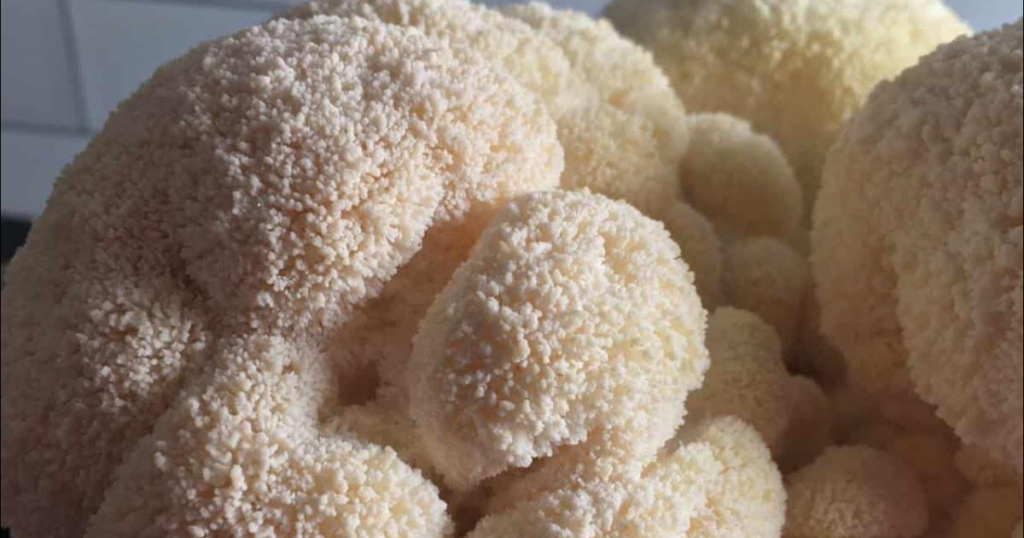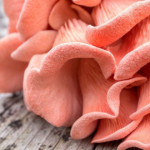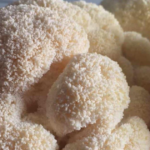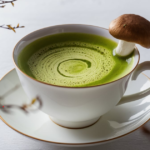Lion’s Mane mushrooms, with their distinctive shaggy appearance, have gained popularity for their potential health benefits and unique flavor. These fascinating fungi, scientifically known as Hericium erinaceus, are prized by foragers, chefs, and health enthusiasts alike. This guide will explore various ways to find Lion’s Mane mushrooms in your local area.
Whether you’re interested in foraging for wild specimens or purchasing cultivated Lion’s Mane, we’ll cover everything you need to know. From identifying these mushrooms in nature to finding reliable suppliers, this comprehensive guide will help you locate Lion’s Mane mushrooms near you.
Understanding Lion’s Mane Mushrooms
Identifying Lion’s Mane in the Wild
Lion’s Mane mushrooms are easily recognizable due to their unique appearance. They grow in cascading clusters of long, thin, white spines that resemble a lion’s mane or a waterfall. These mushrooms typically appear on hardwood trees, particularly oak, maple, and beech.
When foraging for Lion’s Mane, look for large, white, globular growths on dead or dying hardwood trees. The spines should be soft and pliable, ranging from 1 to 5 cm in length. Always ensure proper identification before consuming any wild mushrooms.
Lion’s Mane Habitat and Growing Seasons
Lion’s Mane mushrooms are primarily found in the northern hemisphere, including North America, Europe, and Asia. In the United States, they’re most common in the eastern and midwestern regions. These fungi prefer temperate climates and are typically found in mature, mixed hardwood forests.
The growing season for Lion’s Mane varies depending on your location. In most areas, they can be found from late summer through fall. Some regions may see growth as early as late spring or as late as early winter.
Foraging for Lion’s Mane Mushrooms
Best Practices for Mushroom Foraging
When foraging for Lion’s Mane, safety and sustainability should be your top priorities. Always follow these best practices:
- Never consume a mushroom unless you’re 100% certain of its identification
- Obtain necessary permits and follow local regulations for foraging on public lands
- Use a sharp knife to carefully cut the mushroom, leaving the base intact
- Carry your finds in a breathable basket or mesh bag to allow spore dispersal
- Leave some mushrooms behind to ensure future growth and ecosystem health
Remember, responsible foraging helps preserve mushroom populations and their habitats for future generations. Always respect nature and leave no trace.
Top Locations for Finding Wild Lion’s Mane
While specific locations can vary, here are some general areas where you might find Lion’s Mane:
- Old-growth hardwood forests, especially those with oak, maple, or beech trees
- State and national parks with mature forests (check local regulations first)
- Nature preserves and wildlife management areas
- Private woodlands (with owner’s permission)
- University or botanical garden forests that allow foraging
Before venturing out, research local mushroom clubs or foraging groups in your area. They often organize guided forays and can provide valuable local knowledge.
Purchasing Lion’s Mane Mushrooms

Local Farmers Markets and Specialty Stores
Many local farmers markets now feature vendors selling cultivated mushrooms, including Lion’s Mane. These markets offer fresh, locally grown produce and support small-scale farmers. Visit your nearest farmers market and look for specialty mushroom vendors.
Specialty grocery stores and health food shops often stock Lion’s Mane mushrooms. These stores usually offer both fresh and dried varieties. Check with your local natural food co-ops, organic grocery stores, and gourmet food shops.
Online Retailers and Mushroom Farms
Numerous online retailers specialize in gourmet and medicinal mushrooms, including Lion’s Mane. These platforms offer a wide range of products, from fresh and dried mushrooms to powders and supplements. Research reputable online mushroom suppliers and read customer reviews before making a purchase.
Many mushroom farms now sell directly to consumers through their websites or social media platforms. Look for small-scale mushroom farms in your region that offer local pickup or delivery options. Supporting these local growers ensures freshness and reduces transportation-related environmental impact.
Growing Your Own Lion’s Mane Mushrooms
Home Cultivation Methods
Growing Lion’s Mane at home can be a rewarding experience. There are several methods to choose from:
- Log cultivation: Inoculate hardwood logs with Lion’s Mane spawn
- Sawdust blocks: Use sterilized sawdust mixed with mushroom spawn
- Ready-made kits: Purchase pre-inoculated blocks for easy indoor growing
- Liquid culture: Advanced method for creating your own mushroom spawn
Each method has its advantages and challenges. Research thoroughly and choose the one that best fits your space and skill level.
Supplies and Resources for Mushroom Cultivation
To start growing Lion’s Mane, you’ll need some basic supplies:
- Mushroom spawn or a ready-made growing kit
- Substrate material (logs, sawdust, or specialized mushroom growing medium)
- Sterilization equipment (if preparing your own substrate)
- Humidity control tools (spray bottle, humidity tent, or automated system)
- Temperature monitoring device
- Patience and attention to detail
Many online retailers specialize in mushroom cultivation supplies. Look for reputable suppliers with good customer reviews and educational resources.
You Like To Read More:
Lion’s Mane Mushroom Products and Supplements
Types of Lion’s Mane Products
Lion’s Mane is available in various forms beyond fresh mushrooms:
| Product Type | Description | Common Uses |
| Dried Mushrooms | Dehydrated whole or sliced Lion’s Mane | Rehydrate for cooking, make tea |
| Powders | Finely ground dried mushrooms | Add to smoothies, coffee, or recipes |
| Tinctures | Liquid extracts of Lion’s Mane | Take orally for potential health benefits |
| Capsules | Powdered mushroom in pill form | Convenient daily supplement |
| Extracts | Concentrated forms of beneficial compounds | Add to beverages or take directly |
Choose the product type that best fits your lifestyle and intended use. Always follow recommended dosages and consult with a healthcare professional before starting any new supplement regimen.
Choosing Quality Lion’s Mane Supplements
When selecting Lion’s Mane supplements, consider the following factors:
- Look for products made from 100% fruiting bodies, not mycelium on grain
- Check for third-party testing and quality certifications
- Read ingredient lists carefully and avoid unnecessary additives
- Consider the extraction method used (hot water, alcohol, or dual extraction)
- Research the brand’s reputation and manufacturing practices
- Compare prices, but remember that quality often comes at a higher cost
Always purchase supplements from reputable sources and be wary of products making exaggerated health claims. Quality matters when it comes to mushroom supplements.
Cooking with Lion’s Mane Mushrooms
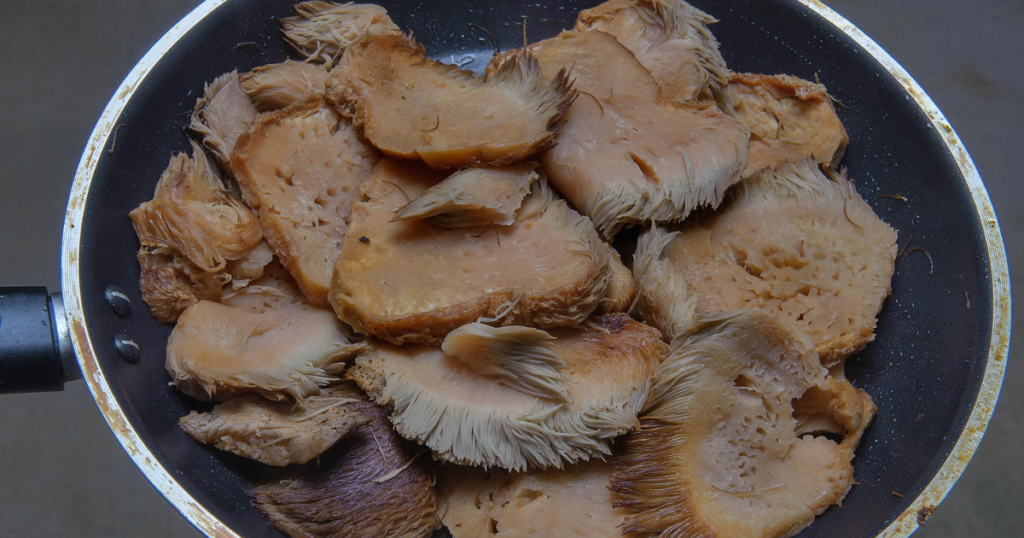
Preparing and Storing Fresh Lion’s Mane
Proper handling of fresh Lion’s Mane ensures the best flavor and texture:
- Clean gently with a soft brush or damp cloth to remove debris
- Avoid soaking in water, as mushrooms absorb moisture quickly
- Slice or tear into bite-sized pieces before cooking
- Store in a paper bag in the refrigerator for up to a week
- For longer storage, slice and dehydrate or sauté and freeze
Fresh Lion’s Mane has a delicate flavor that’s best enjoyed soon after harvesting. Use within a few days for optimal taste and texture.
Popular Lion’s Mane Recipes
Lion’s Mane’s mild, seafood-like flavor makes it versatile in many dishes:
- Sauté in butter or olive oil for a simple side dish
- Use as a meat substitute in vegetarian “crab cakes”
- Add to stir-fries, soups, or pasta dishes
- Bread and fry for a crispy, seafood-like appetizer
- Slice thinly and use raw in salads for a unique texture
Experiment with different cooking methods to find your favorite way to prepare Lion’s Mane. Its ability to absorb flavors makes it adaptable to various cuisines.
Conclusion
Finding Lion’s Mane mushrooms near you opens up a world of culinary and potential health benefits. Whether foraging in local forests, shopping at farmers markets, or growing your own, there are many ways to access these unique fungi.
Remember to prioritize safety when foraging and choose high-quality products when purchasing supplements. Experiment with different recipes to enjoy Lion’s Mane’s versatility in the kitchen.As interest in Lion’s Mane grows, more local sources are likely to become available. Stay curious, continue learning, and enjoy your journey into the fascinating world of Lion’s Mane mushrooms.
FAQs
Are Lion’s Mane mushrooms safe to eat?
Lion’s Mane is generally considered safe for most people. However, always ensure proper identification when foraging and consult a doctor if you have allergies.
Can I grow Lion’s Mane mushrooms indoors?
Yes, Lion’s Mane can be grown indoors using methods like sawdust blocks or ready-made kits. Proper humidity and temperature control are essential.
How long does it take to grow Lion’s Mane mushrooms?
From inoculation to harvest, it typically takes 1-3 months. This can vary depending on growing conditions and method used.
What does Lion’s Mane mushroom taste like?
Lion’s Mane has a mild, slightly sweet flavor often compared to seafood like crab or lobster. Its texture is meaty and tender.
Are there any side effects of taking Lion’s Mane supplements?
While generally safe, some people may experience mild side effects like upset stomach. Always follow recommended dosages and consult a healthcare provider.

